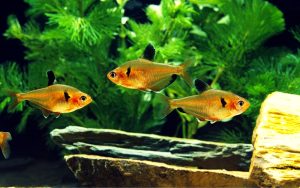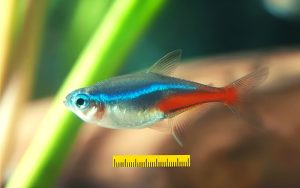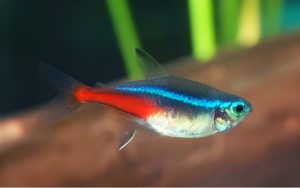Have you ever asked how to tell if ghost shrimp eggs are fertilized? If so, you’ve come to the right web page. This article will share valuable insight into egg fertility and what it means for aquatic creatures.
If you’re an aquarium or fish enthusiast, you might be familiar with ghost shrimp. These small, transparent crustaceans are my favorite pets due to their distinctive look and ease of care.
One fascinating aspect of ghost shrimp is their reproductive process, which involves female ghost shrimps carrying hundreds of eggs on their bodies.
However, not all these eggs are fertilized, and it can be harsh to tell which ones will hatch into baby ghost shrimp.
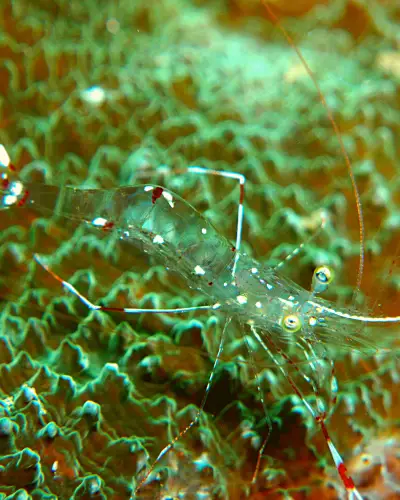
How to tell if shrimp eggs are fertilized? Understanding whether or not a ghost shrimp’s eggs are fertile can be difficult. Still, with just a few tips, you’ll know why sure eggs may not hatch and helpful information about these incredible invertebrates.
In this blog post, we’ll explore how to tell if ghost shrimp eggs are fertilized and provide you with tips to ensure a successful hatch.
Whether you’re a seasoned aquarium owner or new to the fish-keeping hobby, this guide will help you understand the fascinating world of ghost shrimp reproduction and ensure your pets’ health.
So keep reading on and find out all you need about identifying fertilized ghost shrimp eggs!
Table of Contents
ToggleUnderstanding Ghost Shrimp Eggs
Before we delve into identifying fertilized eggs, it’s essential to understand their anatomy. Ghost shrimp eggs are small, translucent capsules that females carry attached to their swimmerets, located on the underside of their abdomen.
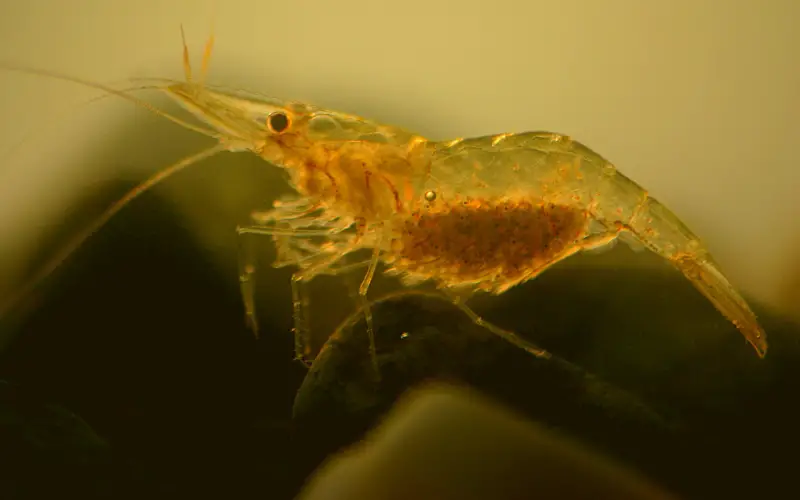
Each capsule, known as an ootheca, can contain hundreds of eggs. These eggs develop and hatch into juvenile ghost shrimp. Females must carry the eggs until the larvae are ready to hatch, which can take up to ten days.
The ootheca is an integral part of the shrimp’s reproductive cycle since it protects the eggs and helps keep them warm and moist.
Can Ghost Shrimps Breed In Community Tanks?
Yes, ghost shrimp are possible to eat in community tanks, but success rates are generally meager. The fish will feed on these larvae while their growth begins.
Often old ghost shrimp devour young ghost shrimp. Instead of breeding ghost shrimp, you could transfer them to another community tank somewhere. This can make a good and cheaper substitute: a breeding box.
This is another Fluval that I have used several times. The tank hangs from the outside to save the tank space from being used.
Pregnancy Phases for Female Ghost Shrimp
Like other crustaceans, ghost shrimp do not get pregnant as mammals do. Instead, female ghost shrimp carry their eggs externally on their pleopods, the swimmerets on their abdomen. Tiny hair-like structures called setae initially attach the eggs to the pleopods.
The reproductive process of ghost shrimp can be divided into several phases. First, the female will release pheromones to attract the male ghost shrimp to mate with. Once a male is found, he will deposit sperm onto the female’s pleopods, where the eggs are fertilized.
After fertilization, the eggs will remain attached to the female’s pleopods for about 2-3 weeks, during which time they will develop and change from bright green to darker shades.
As the eggs near hatching, they will become more translucent, and it will be easier to see the developing baby ghost shrimp inside.
Once the eggs hatch, the baby shrimp will emerge as tiny larvae requiring specific care to survive. It’s crucial to provide them with a suitable environment, proper nutrition, and adequate filtration to ensure their survival and growth.
In summary, the reproductive process of ghost shrimp involves several phases, including the release of pheromones to attract a mate, fertilization of the eggs, and carrying eggs externally on the female’s pleopods.
It’s essential to provide proper care to both the parent shrimp and the baby ghost shrimp to ensure their health and well-being.
How Can You Tell When Your Ghost Shrimp Is Pregnant?
It is a simple way to know when a ghost shrimp is pregnant or has eggs, and these methods depend upon closely observed gravid shrimp. Here are some hidden signs that you should consider when trying to understand whether a female ghost shrimp is pregnant:
– Attention from Male Shrimps
Your pregnant female ghost shrimp will likely receive lots of male interest, sometimes unwanted, when males try fertilizing their egg. Hence if you observe many ghost shrimps hovering over females, this could be a warning to expect a pregnancy from a male.
– White or Green Dots Under Her Tail
Once males fertilize these eggs, they should start to turn white. It is white when fertilized, but they may be moved lower in their saddle in front of their rear legs.
– Consistent Leg Fanning or Splaying
A common sign of a pregnant shrimp is consistent leg fanning or splaying. This is where the female will stretch out her rear legs and move them back and forth to keep her eggs oxygenated.
– Changes in Behavior
Pregnant ghost shrimp often become more active and should be observed closely for strange behavior. Another sign of ghost shrimp pregnancy is that they may become shy or hide from other pregnant ghost shrimp in the tank.
– Weight Gain
Pregnant ghost shrimp may also become heavier due to the weight of their eggs. This is especially noticeable when the female is full of eggs, where her body may appear to be swollen.
By looking out for these signs and observing the behavior of your male shrimp and female ghost shrimp, you can tell when she is pregnant and prepared to care for her eggs.
It’s essential to provide a suitable environment for your adult ghost shrimp during pregnancy, such as a main aquarium with low water flow and plenty of hiding places and live plants. This will help your mother shrimp to feel secure, allowing her to focus her energy on caring for her eggs.
How to Tell If Ghost Shrimp Eggs Are Fertilized
How do I know if ghost shrimp eggs are fertilized? It is probably the clearest sign your shrimp are pregnant. If you observe the white stripes beneath the tail of shrimps, then you know the mate has completed the gestation period and has already carried a clutch of eggs.
Identifying Fertilized Ghost Shrimp Eggs: Now that you know the basics of shrimp eggs, let’s see how to tell if they’re fertilized. Generally, fertile eggs will have a dark spot or ring in the capsule’s center, while infertile eggs won’t.
Here are some symptoms to consider when identifying a fertilized egg:
5 Signs of Fertilized Ghost Shrimp Eggs
1. Color and Appearance
Fertilized ghost eggs typically have a slightly opaque appearance. Depending on the species, the egg’s color can range from light green to dark brown. The eggs may be somewhat round or elongated, resembling tiny rice grains.
2. Development of Eyes
One of the early signs of fertilization is the development of eyes within the eggs. As the eggs mature, you may notice tiny black and white dots within or little green dots indicating the presence of developing eyes. This signifies that fertilization has taken place.
3. The Movement inside the Eggs
If you observe the eggs closely, you may notice slight movements or twitching within them. The growing embryos inside the eggs cause this movement. It indicates that the eggs are fertile and that the embryos are developing.
4. Presence of a Dark Spot
A fertilized ghost shrimp egg often has a dark spot or area near the center. This dark spot is the developing embryo itself. It indicates that the shrimp egg has been fertilized and is progressing toward hatching.
5. Shape and Texture
Fertilized ghost eggs tend to have a consistent shape and texture. They are relatively firm to the touch and maintain their overall structure. If the eggs appear plump and hold their body, they are fertile.
Signs of Unfertilized Ghost Shrimp Eggs
In some cases, glass shrimps produce eggs that may not be fertilized, and it’s essential to identify these unfertilized eggs.
Transparent and Empty Appearance
Unfertilized shrimp ghost eggs often appear transparent or translucent. They may appear empty, indicating that they do not contain developing embryos. These eggs lack the opaqueness and coloration observed in fertilized eggs.
Lack of Development
Unfertilized eggs show no signs of development. They do not have any visible eyes or noticeable growth within the eggs. The lack of any signs of progression indicates that the eggs are not fertilized.
No Movement
Unlike fertilized eggs, unfertilized shrimp ghost eggs do not exhibit any movement. They remain still and do not show any twitching or activity inside the capsules. This absence of motion indicates that fertilization has not occurred.
No Dark Spot
Unfertilized shrimp ghost eggs do not have a dark spot or area. The absence of a dark spot suggests that the eggs are not fertilized, as the dark spot signifies the presence of a developing embryo.
Factors Affecting Shrimp Eggs Fertilization
Several factors can influence the fertilization of shrimp eggs. Understanding these factors can help you create optimal conditions for successful egg fertilization.
– Mating Behavior of Ghost Shrimp
Ghost shrimp are known for their elaborate mating rituals. Proper mating behavior, including successful mating and sperm transfer, is crucial for fertilization. An environment that encourages natural mating behaviors, such as ample hiding places and suitable tank conditions, can increase the chances of successful fertilization.
– Water Parameters
Maintaining appropriate water parameters is essential for the health and fertility of ghost shrimp. Ensure that the water temperature, pH levels, and salinity are within the recommended range for the specific species of ghost shrimp you are keeping. Stable and clean water conditions promote successful fertilization.
– Diet and Nutrition
A well-balanced shrimp diet plays a vital role in the reproductive health of ghost shrimp. A varied diet that includes high-quality shrimp pellets, algae, and other suitable food sources ensures that the females have the necessary nutrients to produce healthy eggs. Proper nutrition increases the likelihood of successful fertilization.
Caring for Fertilized Ghost Shrimp Eggs
Once you have identified fertilized eggs, providing the necessary care to maximize the chances of successful hatching is crucial.
Here are some tips for caring for fertilized eggs:
Maintaining Water Quality
Maintain excellent water quality throughout the incubation period. Regular water changes, careful monitoring of water parameters, and filtration are essential. Avoid sudden changes in water conditions, as they can negatively affect the developing embryos.
Providing Adequate Nutrition
During the incubation period, providing the female ghost shrimp with a nutritious diet is essential. Offer small, high-quality food particles that the female can easily consume. Nutrient-rich foods promote healthy embryo development.
Protecting the Eggs from Predators
Ghost shrimp eggs are vulnerable to predation by other tanks and inhabitants. Consider moving the mother ghost shrimp with the attached eggs to a separate tank or use a breeding net to protect them from potential predators. This ensures a higher survival rate for the fertilized eggs.
Caring For Pregnant Ghost Shrimps
Set up a breeding tank with sufficient space and provide the pregnant ghost shrimp with a nutrient-rich diet to ensure healthy eggs. Watch for signs of mating behavior and ensure that all water parameters are in the optimal range.
After observing the pregnant ghost shrimp, immediately take them into your breeding tank. Please keep calm and avoid harming the mother’s pregnant ghost shrimp. Utilize a net and quickly move it into a seasoned ghost shrimp fry tank.
Please keep them in the same area at all times for female transfer. They have gotten a reputation for dropping their eggs during stress. Once eggs start fertilizing, an initial 1-2 weeks incubation may occur. These days, it is critical that provide shrimps get nutrients.
Feed your pregnant ghost shrimp several times daily with high-quality, protein-rich food. Ensure also maintain the cleanliness of the natural environment of the tank and manage water parameters.
After the incubation period, you may notice larvae hatching from the eggs. Depending on their species, ghost shrimp larvae may require different feeding and tank conditions.
For baby ghost shrimps, for example, some species may need to be fed Artemia nauplii (baby brine shrimp), while others may require a different type of food such as liquid fry food. It is essential to understand the species-specific needs before attempting to raise them.
Commonly Asked Questions about Fertilized Ghost Shrimp Eggs (FAQ)
What color are fertilized shrimp eggs?
The egg can be green or white, depending on its color. During the hatching season, it becomes darker as the shrimp matures. As the eggs near their final development phase, tiny black eye spots are visible on the developing shrimp inside.
How Many Babies Do Ghost Shrimp Have?
Ghost shrimp are known for prolific breeding; a single female can lay hundreds of eggs simultaneously. A pregnant ghost shrimp can lay 100 to 400 eggs in one clutch.
How Do You Know When Your Shrimp Ghost Is About to Give Birth?
The eggs’ appearance and the behavior of the female ghost shrimp suggest that fries will start hatching soon. Before they hatch, you can see indications of the fertilized eggs on the female’s underside.
How long after ghost shrimp lay eggs do they hatch?
After a pregnant ghost shrimp lays eggs, it usually takes 2-3 weeks for them to hatch. However, the time it takes for the eggs to hatch can vary depending on factors such as water temperature, water, food quality, and the health of the parent shrimp.
What is the perfect way to care for fertilized ghost shrimp eggs?
The best way to care for fertilized ghost shrimp eggs is by ensuring that water parameters such as temperature, pH level, and ammonia levels are stable.
What are the stages of pregnant ghost shrimp?
If female ghost shrimps are pregnant, they have three stages. It comprises the eggs, egg layers, and post-egg phases. The pre-egg phase occurs when the female shrimp carries a meal into the female’s abdomen and eats it before laying eggs.
Are all berried shrimp eggs fertilized?
Observing eggs in her breast does not imply a fertilized egg. Even when she doesn’t have males swimming around, she can still keep the shrimps on their shoulders.
Conclusion
Determining if ghost shrimp eggs are fertilized is crucial for providing the appropriate care and environment for successful hatching. You can identify fertilized eggs by observing signs such as color and appearance, development of eyes, movement inside the eggs, presence of a dark spot, and overall shape and texture. Unfertilized eggs, on the other hand, appear transparent, lack signs of development, show no movement, and do not have a dark spot. Creating optimal conditions for fertilization, including promoting natural mating behavior, maintaining suitable water parameters, and providing a nutritious diet, increases the chances of successful fertilization. Caring for fertilized eggs involves maintaining water quality, providing adequate nutrition, and protecting the eggs from predators. Happy breeding ghost shrimp.
You Might also like
- What Does Grass Shrimp Eggs Look Like: (5 Common Questions)
- How Long Does It Take for Ghost Shrimp Eggs to Hatch: (Must-Read)
- Pregnant Ghost Shrimp Breeding Stages: (5 Successful Breeding Tips)
- Can Ghost Shrimp Live with Other Shrimp In the Same Tank: (Must-Read)
- How Long Do Ghost Shrimp Hold Their Eggs: (A Comprehensive Guide)
- Do Ghost Shrimp Lay Eggs: What to Expect and What to Do?
- How Long Do Ghost Shrimp Carry their Eggs: (A Definitive Guide)
- Shrimp Eggs in Aquarium: The 7-Step Guide to Hatching Success
- How Many Babies Can a Ghost Shrimp Have: A Comprehensive Guide
- Why Are Ghost Shrimp So Cheap: (5 Astonishing Reasons)


